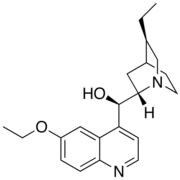
| |
| Names | |
|---|---|
| IUPAC name
(4β,8α,9R)-6'-Ethoxy-10,11-dihydrocinchonan-9-ol
| |
| Other names
Ethylhydrocupreine
| |
| Identifiers | |
3D model (JSmol)
|
|
| ChEBI | |
| ChEMBL | |
| ChemSpider | |
| ECHA InfoCard | 100.007.577 |
| MeSH | Optochin |
PubChem CID
|
|
| UNII | |
CompTox Dashboard (EPA)
|
|
| |
| |
| Properties | |
| C21H28N2O2 | |
| Molar mass | 340.46 g/mol |
Except where otherwise noted, data are given for materials in their standard state (at 25 °C [77 °F], 100 kPa).
| |
Optochin (or ethylhydrocupreine hydrochloride) is a derivative of quinine introduced in 1911 by Morgenroth and Levy with the intention to treat pneumococci infection.[1] In very high dilutions, it inhibits the growth of representatives of all four groups of pneumococci in vitro. That is the main reason it is now used in bacteriology for the differentiation of Streptococcus pneumoniae, which is optochin-sensitive, from the other, resistant alpha-hemolytic streptococci, sometimes called the viridans streptococci because of the green colouration on blood agar around colonies.
The growth of bacteria that are optochin-sensitive will show a zone of inhibition around an optochin disc, while the growth of bacteria that are resistant to optochin will not be affected. In vitro, a minimum inhibitory concentration (MIC) of 1:10,000,000 will inhibit the growth of pneumococci, and 1:500,000 is bactericidal.[2]
- ^ Moore HF (1915). "The Action of Ethylhydrocuprein (Optochin) on Type Strains of Pneumococci in Vitro and in Vivo, and on Some Other Microorganisms in Vitro". J. Exp. Med. 22 (3): 269–85. doi:10.1084/jem.22.3.269. PMC 2125335. PMID 19867915.
- ^ "Ethylhydrocupreine".